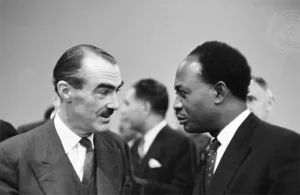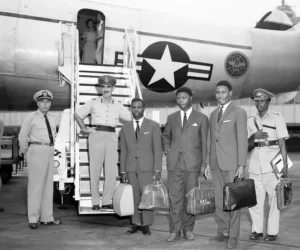From PRO IUNVA
Mass Murder of UN Peacekeepers in the Congo in April 1961.
Sixty one years ago, in Apr 1961, the UN suffered heavy casualties in a murderous rampage by members of the Armed Forces of the Central Congolese Government.
On 28 April 1961, ONUC suffered its highest number of fatalities in single event at Port Francqui, on the Kasai River when forty seven UN personnel were murdered by members of Armée Nationale Congolaise (ANC), the Congolese National Army. Looking back to the first year of Opération des Nations Unies au Congo (ONUC), many will find this atrocity hard to understand when you consider that the UN went to the Congo to help the country and one of the terms of the original mandate was: “to assist the Government in maintaining law and order and to provide technical assistance”.
Port Franqui, in Kasai Province, was the terminus for the railway company Bas Congo Katanga (BCK) and it was the port where cargo was transferred from barges on the Congo – Kasai rivers to the railway network. It was an important transport hub for UN supplies and food relief for the famine districts in south Kasai and, as such, it was a vital UN post. Apart from air travel, it was the most used transport system between Leopoldville and Elisabethville.
The UN garrison consisted of ninety three personnel from A Coy, 2 Ghana Rifles and three Swedish Movement Control personnel. They were dispersed in several locations around the town, A Coy HQ was at Socopetrole petrol dump; the Hotel des Palmes, the railway station, the powerhouse, the docks, the airfield and three houses were used for accommodation.
Congolese forces in Port Francqui amounted to approximately one hundred ANC personnel and ninety armed civilian police.
On 26 Apr 1961, Emery Wafwana, Minister of Interior of Luluabourg Province visited Port Francqui and he made an inflammatory speech threatening to have the ANC disarmed by ONUC. The ANC reacted with hostility to the minister and the UN personnel had to escort him to his aircraft. The situation remained very tense overnight and on the following morning the ANC surrounded the UN positions and forcibly disarmed the garrison.
On the evening of 27 Apr, word reached the Ghanaian Bde HQ at Luluabourg; that the garrison had been disarmed, it was decided to send reinforcements, (approximate strength 40) to assess the situation. They arrived at the outskirts Port Francqui on the following morning 28 Apr and they were ambushed by the ANC and suffered one killed and three wounded, two ANC were killed in the firefight. As a result, the ANC and civilian police started to shoot the disarmed peacekeepers in the town, some managed to escape into the bush, some of those were wounded and they died in the bush. Others were shot and their bodies were thrown into the river Kasai. The ONUC garrison consisted of 4 officers and 89 enlisted personnel from the Ghanaian contingent, 3 of the officers were seconded British Army officers [Ghana had gained independence from Britain in 1957 and British officers were seconded to the Ghanaian Armed Forces], a Swedish Movement Control of one officer and two NCOs.
Two British Army officers attached to the Ghanaian contingent (Capt Trevor Ralph, Coy Comd, Lt Anthony Brown, Coy 2 I/C), thirty nine Ghanaian enlisted personnel and one Swedish officer (2/Lt Carl Wilhelm Bottiger) and one Swedish Warrant Officer (W/O Lars Thorsten Liedgen) were posted missing presumed dead and their remains were never recovered. The remains of three Ghanaian soldiers were found, they were the only bodies recovered from the massacre. According to UN records, 47 UN personnel were killed.
From 29 Apr, ground and air searches were conducted and a number of Ghanaians were found over the following days.
The final paragraph of the ONUC Board of Inquiry findings reads as follows:
“As has already been stated, the main cause which initiated the events was the arrival, without prior notice to the local Congolese authorities, of the two Congolese officials, the Minister of Interior and the Commissaire of the District of Kasai on Wednesday the 26th April and their demand for UN protection. The basic reason that such terrible events could follow such a seemingly small cause for friction was the lack of discipline among ANC, to such a degree that their officers and NCOs had no control and they were in fact an armed mob.”
Of the thirty ONUC troop-contributing countries, Ghana had the highest number of fatalities with 49 deaths in total.
The massacre was reported in media across the world. The Irish Independent and the Irish Press carried reports as the story unfolded, on 1 May 1961 the reports quoted a UN spokesman in Leopoldville expressing “grave anxiety” for sixty of the UN Ghanaian troops and about half of the garrison being unaccounted for. By 2 May the reports covered forty Ghanaian survivors who had been flown to Lulabourg, capital of Kasai Province. On 4 May the report mentioned the three Ghanaian bodies recovered and forty one unaccounted for. The Irish Press had the story as the main item on page one under the headline “26 GHANAIANS DIE – Beheaded Men in River”.
The massacre is mentioned in the unit history of 1 Inf Gp, the Irish group had taken over positions from elements of the Ghanaian Bde at Luputa, Kashia and Mwene Ditu in Kasai Province and later at Kamina Base and Nyunzu in Katanga Province.
Extracts from the unit history:
Para 8. “In April, a UN company of’ the GHANA Contingent had been lured into being taken unawares at Port FRANCQUI and were wiped out. As a result, Standard Operating Procedure decreed that all UN patrols be of at least Platoon strength, a requirement which the Gp had great difficulty in complying with due to numerous other duties”.
The history also mentions the assistance provided to 1 Inf Gp by the Ghanaian contingent.
Para 11. “As the first UN contingent of white troops to serve in the province, the Gp found climate and living conditions far different from anything encountered heretofore. In their task of settling in and getting organised it must be said that every assistance and advice was forthcoming from the British officers serving with the Ghana Contingent and they proved most helpful throughout the Gp’s service with Ghana Bde. The Bde Comd visited Gp HQ on several occasions to discuss problems and difficulties as they arose and, where possible, the resources of the Bde were used to our advantage. The Unit was also visited by General Alexander (BRITISH), Chief of Staff of the Ghanaian Army”.

This photograph was taken at UN HQ in New York in Mar 1961 and it shows Dr Kwame Nkrumah, President of Ghana and Maj Gen Henry T Alexander, COS of the Ghanaian Army. Photo credit UN Multimedia. Gen Alexander commanded the Ghanaian contingent in the Congo.
Gen Alexander with personnel from the Ghanaian Ministry of Foreign Affairs in Jul 1960 prior to the Congo deployment.

